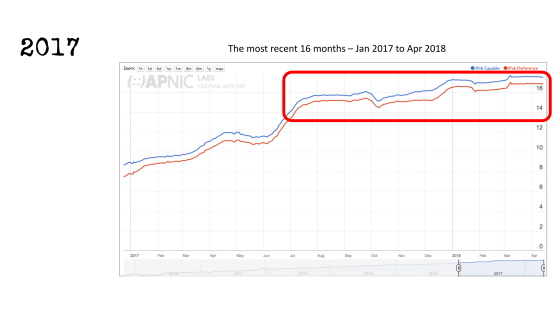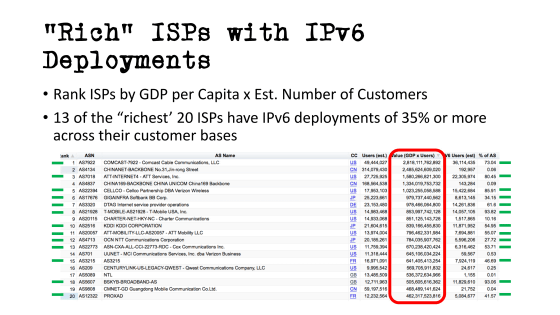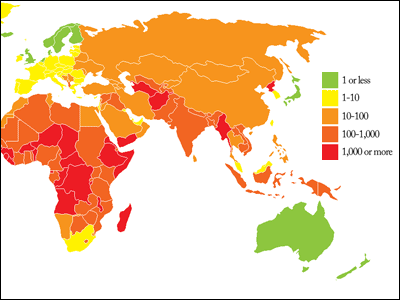Why does IPv6 not spread?

IPv6The address isIPv4 address exhaustion problemIt appeared in 1999 to solve the problem. However, as of 2018 as close as 20 years since its appearance the mainstream IP addressIPv4It is difficult to say that "IPv6 has become popular". Distribute IP address to East Asia, South Asia / Pacific AreaAPNICIs considering the reason for "why IPv6 is not popular".
Is IPv6 only for the Rich?
(PDF file)https://ripe76.ripe.net/presentations/9-2018-05-17-ipv6-reasons.pdf
The following image is a graph showing the diffusion of IPv6 as of 2017. The horizontal axis shows the time axis, and the vertical axis shows the penetration rate (%). Users who can access only IPv6 sites with blue lines, red lines show users that can access IPv6 / IPv4 sites at both IPv6 and IPv4, both graphs have been steadily rising year after year, and the whole It has reached nearly 20%. However, when I focused on the closest part of red frame to 2017 ... ...

The graph is getting capped, and the spreading speed tends to be slowing down from the survey for the most recent nine months.

The reasons for APNIC's reasons for the slow spread of IPv6 are attributed to "the things that have promoted the penetration of IPv6 so far are not effective". So, what was the reason for promoting the spread of IPv6 so far?
One factor that can be considered is a hugeInternet service provider (ISP)It is influence by. The number of users that ISP has in order from the top, it becomes the table below, and the top six ISPs are monopolized in India and the United States.

By multiplying the number of ISP customers by the country's GDP per capita, APNIC has created a ranking that takes into account the country's wealth. When summarizing the top 20 companies of ISP with a large number of red frames (wealthy), only 13 customers with green marks in this accounted for more than 35% of IPv6 addresses.

It can be said from the above that although it can be said that the influence of wealthy ISP is strong for the spread of IPv6, APNIC states that it can not be concluded that this is a factor, because it is an ISP outside the top 20 rank which carries more than half the IPv6 address .
Next I will examine it from the viewpoint of the growth degree of ISP by changing viewpoint. The table below summarizes the top 30 ISPs whose number of customers has increased significantly (in the red frame portion) in the past 16 months. The top is Thailand's ISP, the growth rate is 372%, the second place is Korean ISP 355%, the top two companies have grown more than three times. However, most of these ISPs focus on IPv4 addresses and are not aggressive in investing in building IPv6 infrastructure. For this reason, these ISPs have more than 10% of the influence of the whole IPv6, and it can not be said that they are strongly contributing to the spread of IPv6.

Next, ISPs that have many customers (red frames) are arranged from the top ... ...

We extract 418 ISPs with more than 1 million customers and check how much each ISP is proactively investing in IPv6 with a distribution map. The vertical axis shows the number of IPv6 addresses handled by ISP, and the horizontal axis shows the number of customers. Then, there are 81 ISPs that are actively investing in IPv6, and the remaining 337 ISPs are located at the bottom of the distribution chart and have not actively invested. Even if we have many customers, we do not seem to contribute to the spread of IPv6. In addition to these ISPs, most ISPs show similar trends, and ISPs that are actively investing in IPv4 tend not to place much emphasis on IPv6.

However, this trend is not a factor that impedes the spread of IPv6 addresses. In fact, the available addresses are decreasing due to the depletion of inventory of IPv4 addresses, but since it is expected that the needs of new addresses will continue to increase in future, these ISPs will introduce IPv6 addresses because of the APINIC says it is a problem.
For these reasons, APNIC has stated that it can not clearly assert "what is promoting IPv6 penetration", and conversely concludes that the reason why the spreading speed of IPv6 is slowing down is not well understood.

Related Posts:
in Note, Posted by darkhorse_log







